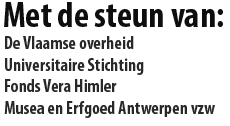A.K.L. THIJS
Drukvormen voor mannekensbladen van Brepols & Dierckx Zoon (Turnhou): Een gebruikstraject van volkscultureel erfgoed gereconstrueerd
Summary: Printing forms for folk- and children prints by Brepols & Dierckx Son (Turnhout): A reconstruction of the multi-purpose of popular culture heritage
The story of the wooden printing forms that the popular expert Emile van Heurck bought from the rinting-publishing
house Brepols in 1905 is an illustration of the cultural custom to use objects for different purposes during their existence.
For the Brepols company, these printing forms where part of their working capital. The day their economic use was over, they were condemned to the rubbish dump. However, E. van Heurck considered them to be pearls beyond price of popular culture. Aside from an emotional and scientific value, he also recognized a practical meaning. He used them to illustrate some of his publications. He also found a use for them in developing his network of friend-popular experts, namely by placing them at their disposal as illustration material. The important meaning he attributed to these objects drove him to donate them to the Museum of Folklore in 1924. The curator Victor de Meyere used many of them to adorn his book ‘De Vlaamsche Volkskunst’ (The Flemish Popular Culture). Under his successors the Brepols printing forms suffered the very precarious fate of the complete museum collection, going from material neglect to scientific revaluation.
,
D. CALLEWAERT
Goud, wierook en mirre
Summary: Gold, incense and myrrh
The three Magi gave the Infant Jesus – according to the evangelist Matthew – three exceptionally expensive presents: gold, incense and myrrh. Gold, made into jewels and sacred vessels or distilled into body and roomspray and gold-and-silver water, has played a role in liturgy, in folk medicine, as well as in beauty-and-wellness circles. Incense and myrrh are both made from different families of resiniferous trees. The smell of incense has been a sovereign remedy against evil spirits. It has also been used for hygienic and aromatherapeutic reasons and on special liturgical occasions. The balsamic resin of myrrh has been considered a medicine (even a cure-all in certain esoteric circles), a beautifier, an inspiring perfume (meditation) and a balsam (mummification / myrrhophores and chrism). It is not always easy to distinguish between religion, magic, esotery and love of pure profit.
,
K. VAN EFFELTERRE,
FW: Schitterend! Narratieve volkscultuur in de mailbox
Summary: FW: marvelous! Narrative popular culture in the mail box
Characterized by inherent dynamics, the narrative popular culture has changed throughout the centuries in from, function and dissemination media under the influence of medial innovations. The oral distribution of the story tale contents, which was initially dominant, has never disappeared but it did develop an interaction with other media which arose by means of important discoveries such as typography, writing machines, photocopiers, fax machines, computers and the internet.
The fast electronic circulation of information also gave a new dimension to the narrative popular culture due to its important impact on the social-cultural life. As it happens, the internet has seen the birth of a new, creative and international narrative culture. The internationally narrative research knows a growing valorization of the internet as a research source and considers the mail box, and more specifically the Forward message, as a new channel for inter-human communication of narrative contents.
Such message – among which for example jokes, modern legends and chain mails – are characterized by their own patterns and give expression to human worries, frustrations and criticisms in the contemporary narrative culture.
,

